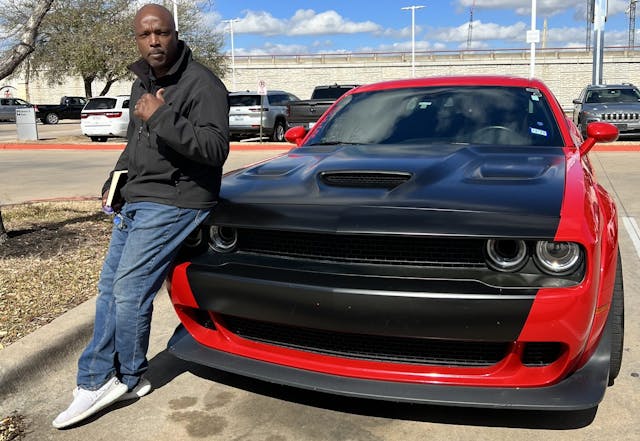Media | Articles
Don’t look now, but we’ve probably reached Peak Speed
There are two ways to get to grips with a fast car: thrash it or baby it—until you can thrash it. The first approach requires balls and expertise. The second requires humility and patience. As a man who’s been humiliated on the track more times than I’ve had hot dinners, I’m a baby it kinda guy. Which is why I didn’t go hell-for-leather when I aimed Kevin Millender’s Dodge Challenger Wide Body Scat Pack 392 onto the highway on-ramp—despite the fact that its owner made me promise I’d make his car my bitch.
As the Challenger entered the onramp at a sensibly quick but far from stupid speed, it heaved sideways like a powerboat. Now what? Add gas? Power slides at 70 miles per hour in a car heavier than neptunium are not in my wheelhouse—not without runoff room and a lot of practice. Dab the brakes? The Challenger’s stoppers doesn’t “do” dab. There’s a mile of pedal travel before its brakes grab like a pair of needle nose pliers. Steady as she goes and ride it out? I’m here aren’t I?
So, the 4308 pounds. Dodge Challenger isn’t a corner carver. Hello? Who buys one to go around bends? Kevin’s maniacal machine and its muscle car ilk are designed for straight-line speed. Press the Challenger’s go-pedal to the carpet. The 485-hp engine bellows like an amphetamine-crazed opera singer. The back end wiggles like an exotic dancer. When the rear tires lock up the Challenger scats, heading for the horizon like an AGM-183 ARRW. More judicious throttle application rockets the car from any rolling speed to any rolling speed with hypersonic determination. Bonus! The Challenger cruises at triple digits with license-losing savoir faire.
All of which led me to a simple conclusion: we’ve reached peak speed. Outright speed, acceleration in particular, is no longer a thing. We have all the speed we need.
Consider the evidence. Motivated by a 280-hp V-6, a Honda Odyssey minivan bullies its way from zero to 60 mph in 6.5 seconds. A EcoBoosted four-cylinder Ford Mustang does it 5.1 seconds. Equipped with an eight-speed automatic gearbox and launch control, a Kia Stinger GT will git ‘er done in 4.7 seconds. Yes, there are slow cars out there, somewhere. A Nissan Rogue SV AWD ambles to 60 in 8.4 seconds. But remember: there was a time when any car that did zero to sixty in under eight seconds was wicked fast. Once it was out of the shop, a 1982 Maserati Merak ($177K in today’s money) ambled from rest to 5 mph over the then-national speed limit in 7.5 seconds.
Marketplace
Buy and sell classics with confidence
You may have noticed that gas-powered cars like the ones above are being replaced by cars whose carbon emissions are hidden at a power plant. Electric cars are the torque of the town—for good reason. The Tesla Plaid may not reach light speed, but its 1.99 second journey from zero to sixty has muscle car owners drowning their sorrows in a bottle of octane enhancer. The Porsche Taycan Turbo S also earns their ire, clocking in at 2.8 seconds. Just ahead of the Audi RS e-Tron GT’s 3.3 second sprint.
Lower down on the price ladder, the $43K Tesla Model Y does the deed in 5.1 seconds. The $46K Polestar 2 makes the move in a respectable 4.1 seconds. Like all EVs, the Model Y and Polestar 2 keep accelerating at the same pace all the way to their 140- and 100-mph top ends. Those numbers may seem to make a mockery of my peak speed declaration, but ask yourself this: how much speed do you need and do you already have it?
As far as I can tell, a Dodge Challenger Scat Pack owner needs as much power/speed as humanly possible. (Preferably more than any other owner.) Supercar buyers want that infinite urge in a vehicle that can massacre a tight radius corner. They’ve got it! And then some. Porsche, Ferrari, McLaren, and Lambo owners have so much power on tap they can’t possibly lay it all down in the bendy bits without triggering a handling nanny, dying in a fiery crash, or both. You could say the same’s true for sports cars further down the food chain. And you’d be right.
Enthusiasts are, by nature, insane. They will always lust for thrust—if only for the bragging rights. Thanks to modern manufacturing and engine technology—gas, hybrid and/or full electric—the increments dividing modern vehicles’ speeds are diminishing small. Increasing the importance of heritage, design, handling and, my drug of choice, engine sound. Meanwhile, the vast majority of car buyers are no longer left wanting. Like most car manufacturers, they’ve reached peak speed. How great is that?














I really like this attitude! My favorite vehicle for driving about town is a Bugeye Sprite 0-60 in 21 seconds!
It strangely feels quick off the line, sticks like glue to the corners, and offers the driver an unadulterated feel of open air command with zero touch screen distraction.